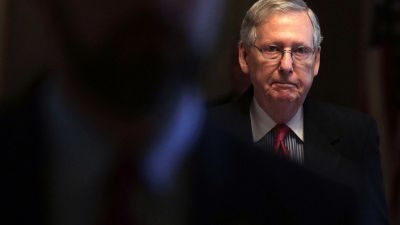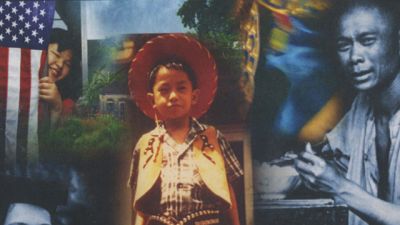
One way to help fix what's broken with journalism: Reporters need to listen for people’s troubles, and find the points where they connect to public issues, writes Jay Rosen. (Photo by Mark Wilson/Getty Images)
This post originally appeared at Press Think.
In Part One of this post, I described in 17 numbered paragraphs a bleak situation for the American press as a check on power, now that Donald Trump has been elected. My summary of it went like this:
Low trust all around, an emboldened and nationalist right wing that treats the press as natural enemy, the bill coming due for decades of coasting on a model in political reporting that worked well for “junkies” but failed to engage the rest of us, the strange and disorientating fact that reality itself seems to have become a weaker force in politics, the appeal of the “strong man” and his propaganda within an atmosphere of radical doubt, the difficulty of applying standard methods of journalism to a figure in power who is not trying to represent reality but to substitute himself for it as a show of strength, the unsuitability of prior routine as professionals in journalism try to confront these confusing conditions, a damaged economic base, weak institutional structure and newsroom monoculture that hinders any creative response, and a dawning recognition that freedom of the press is a fragile state, not a constitutional certainty.
This is a crisis with many overlapping and deep-seated causes, not just a problem but what scholars call a wicked problem — a mess. You don’t “solve” messes; you approach them with humility and respect for their beastliness. Trying things you know won’t “fix” it can teach you more about the problem’s wickedness. That’s progress. Realizing that no one is an expert in the problem helps, because it means that good ideas can come from anywhere.
Being willing to start over is good, too. If I were running a big national desk in DC, I would try to zero-base the beat structure. Meaning: if you had no existing beats for covering national affairs in Donald Trump’s America, if you had to create them all from scratch, what would that system look like?
Is that going to fix what’s broken in political journalism? Nope. But trying it might reveal possibilities that were harder to see before. So let me be clear about this: I don’t have solutions to what I described in Part One. And I’m not saying my suggestions are equal to the task. They are not. Rather, this is what I can think of. I have a series of small ideas that might be worth trying and a larger one to spell out.
I wish had better answers for you.
Measures worth taking (not “solutions.”)
27. Uncouple the news agenda from Trump’s Twitter feed. I don’t agree with those who say the press should ignore Trump’s tweets. Even calling them tweets is in a way an illusion. These are public statements from the president-elect. Bulletins from the top. Naming them for their means of delivery (Twitter) doesn’t help. They can’t be ignored any more than an announcement on whitehouse.gov can be disregarded.
But it is true that Trump uses his Twitter feed to deflect, distract, intimidate, monopolize and confuse. The press should find a way of handling — and fact-checking — these bulletins that shrinks them into a sidebar, or weaves them into a larger story originated by journalists rather than Trump’s Twitter finger. (One option: annotation.) Don’t let his feed set your agenda. And learn to be more careful with your headlines! That may be all he wants: your lazy headline.
28. Switch to an “outside in” (rather than inside out) pattern. Assume almost no access to Trump and the people around him who have power, or imagine that the access game becomes a net negative. Now what? You still have to find out what’s going on, but the “access” portal is closed. This seems to me a better starting point, even as you fight for real access, defend the daily briefing and demand timely responses to Freedom of Information requests.
Outside-in means you start on the rim and work toward the center, rather than the reverse. Domestically, it involves mining sources in the agencies and civil service rather than the people perceived as “players.” (As is commonly done in investigative journalism.) With foreign policy it means more is likely to come from other governments than from the US.
During the Trump campaign, who had better access: The reporters in the media pen, or those who got tickets and moved with the rest of the crowd? Were the news organizations on the blacklist really at a disadvantage? I can hear the reply. We need both: inside and outside. Fine, do both. My point is: Outside-in can become the baseline method, and inside-out the occasionally useful variant. Switch it up. Send interns to the daily briefing when it becomes a newsless mess. Move the experienced people to the rim.
29. Less predictable, please. If Trump can break with established norms so can the journalists who cover him. When you’re not where he expects you to be, you’re winning. I’m not going to elaborate on this because that would defeat the point of listing it.
30. Drop the White House Correspondents Association Dinner. Just stop. You know why.
31. Track closely Trump’s promises and boasts during the campaign so you can compare them to what he is doing. It’s already underway. More like this.
32. From a follower on Twitter: (Good ideas can come from anywhere.) Seek and accept offers to speak on the radio in areas of Trump’s greatest support. Audience development people: this is your gig. Perfect thing to talk about about on red state talk radio: comparing Trump’s campaign promises to what what he has actually done.
33. Make common cause with scholars who have been there. Especially experts in authoritarianism and countries when democratic conditions have been undermined, so you know what to watch for — and report on. (Creeping authoritarianism is a beat: Who do you have on it?)
34. Keep an eye on the internationalization of these trends, and find spots to collaborate with journalists across borders.
35. Try threat modeling the loss of press freedom or the vanished capacity to hold government to account.
36. Find coverage patterns that cross the great divide. For example: “Dave Weigel, who brought his distinct voice and broad knowledge of the far-right and far-left to our 2016 campaign coverage, will do the same on the Hill. He will track Sens. Bernie Sanders and Elizabeth Warren in the Senate, and the Freedom Caucus in the House. He will look for new movements, new factions and new stars. And he will continue reporting on the so-called alt-right and the fake news industry, tracking its origins and spotlighting its authors in real time.”
37. Learn from Fahrenthold! Nothing I have said so far addresses the hardest problem in journalism right now: recovering trust while doing good work. But David Fahrenthold, the Washington Post reporter who uncovered the fiction of Donald Trump’s philanthropic giving, is single-handedly showing the way. It’s not just the great stories he’s digging up, or the way they hold power to account. It’s also the social turn his investigation took, and the lesson in transparency that he’s teaching the press.
Fahrenthold explains what he’s doing as he does it. He lets the ultimate readers of his work see how painstakingly it is put together. He lets those who might have knowledge help him. People who follow along can see how much goes into one of his stories, which means they are more likely to trust it. (And to mistrust Trump’s attacks on it… See how that works?) He’s also human, humble, approachable and very, very determined. He never goes beyond the facts, but he calls bulls–t when he has the facts. So impressive are the results that people tell me all the time that Fahrenthold by himself got them to subscribe.
He is not “solving,” but he’s certainly helping with the trust problem, the revenue problem and the press-hater-in-chief problem (numbers 6, 1, 8 in Part One of this post) all while pumping out Pulitzer-worthy stories that prove to Americans why we have a free press. That’s how a “mess” yields to patient effort. His methods are no mystery. They point the way to a trust restoration and learn-as-you-go project that needs to start tomorrow in journalism. Teams of people should be doing it the way he does it.
Learn from Fahrenthold! I can’t make it any clearer than that.
38. I’m not sure how to put this one, but here goes: Journalists need to think politically about journalism itself, which does not mean to politicize it. Like it or not, the press is a public actor, currently in the fight of its life against forces that want to bring it down. This is a political situation par excellence, but nothing in their training or temperament prepares journalists to fight the kind of battle they’re in. They think they would rather chase stories, publish what they find and let the politics take care of itself. But that won’t cut it anymore.
What I mean by “think politically” involves basic questions: What do we stand for that others also believe in? Who is aligned against us? Where are we most vulnerable? What are our opponents’ strengths? How can we broaden our base? Who are our natural allies? What can we unite around, despite our internal differences? What are the overlapping interests that might permit us to make common cause with people who are not journalists?
There is a reason these (political) questions sound “off” to most people in journalism. A free press has to be independent, or it is useless to us. That remains true, even in the emergency journalists find themselves in today. But staying independent does not mean standing alone. They cannot win this fight alone.
Reacting to their perception of a national emergency, Americans who still have trust in the press are putting money down and signing up for the news sources they want to support. What is that but a form of civic action? It involves not a party or interest group competing for power, but a public good they want to exist: accountability journalism. Nothing else can explain the surge in subscriber revenue following the election of Trump.
From journalists is only one way Americans get news now. They get it directly from newsmakers, as with Trump’s Twitter feed. They get it from ideological cadres styled as news sources, like Breitbart. They get it from entertainers like Rush Limbaugh (an opponent of the press) or John Oliver (an ally of accountability journalism). They get it from friends and family members passing along a personalized mix of stuff. They get it from people interested in the same things who collect online and pool information. They get it from bad actors filling false reports that look like news, like Alex Jones or those Macedonian teenagers.
How to persuade more people to get news from journalism — when they have many other choices at hand — is what I mean by thinking politically, but the wrong way to win that fight would be to politicize the product. This is where the problem of trust in the news media meets problems of practice in journalism; the two things are really one: how to begin to practicing in a way that might begin to expand trust. That’s why I said learn from Fahrenthold. He’s got that part working.
39. Where troubles meet issues: listening better.
After the election we heard this a lot: journalists need to listen better to people outside their current orbit and pick up the signals they somehow missed in 2016. As Jeff Jarvis put it in a morning-after symposium:
The news industry is stuck in its mass-media worldview, trying to create one product for all. Its worldview is limited by its creators’ lack of diversity — ethnic, economic, geographic, political (and let’s finally admit that most media and journalists are liberal).
We must do a much better job of listening to more communities — African-American, Latino, LGBT, women, of course, and also the angry white men (and women) who bred Trumpism — so we can understand and empathize with their needs, serve those needs, gain their trust, and then reflect and inform their worldviews.
We must do a better job of listening… It sounds good: who is not in favor of that? But what does better mean in this context? Better than whom?
Here’s an abstract answer (Sorry; it will only take a minute!) Journalists, I think, need to listen for people’s troubles, and find the points where they connect to public issues. And they have to be better at that than a broken political system is. From there they can start to rebuild trust.
The distinction between “troubles” and “issues” was struck by sociologist C. Wright Mills in the 1950s. He said troubles were the problems that concern people in their immediate experience. “An issue is a public matter: some value cherished by publics is felt to be threatened.” When the issues that get attention fail to connect to people’s troubles, or when common troubles don’t get surfaced and formulated as public issues… that is where journalism-as-listener can intervene, and earn back trust.
A vivid example is the movie Spotlight. Thousands of people were personally troubled by the legacy of child abuse in the Catholic Church. But their private suffering was not a public issue until The Boston Globe made it one — by listening to their stories, piecing them together and confronting the people in power. For The Globe, the gain in reputation from that act was incalculable: years of goodwill in the community, impossible to purchase any other way.
But Spotlight is a once-in-a-lifetime story. More Spotlights is not much of a suggestion, is it?
This call-out was published two weeks after the election by the nonprofit public affairs news site, The Texas Tribune: Help us hear more voices from more Texans. It’s asking people to support with their donations a new position:
Voices not previously heard by the political establishment are being heard now. It’s a good time for the press to hone its listening skills too. This is and always has been — or should have been — a two-way conversation.
That’s why we’re crowdfunding The Trib’s first-ever community reporter position. This reporter will go the extra mile, literally, to forge relationships with our readers all across this state, translating their feedback into stories produced by our awesome reporters. The new position will ensure that the voices of more Texans from more places inform our coverage. This reporter’s beat will be Texans.
The bread-and-butter of The Texas Tribune is government and public policy news. Here it wants to make sure that the issues it reports upon speak to the troubles Texans experience in their lives. The beat is “Texans” because that is one way to make sure the listening gets done. It’s a modest start (one person, one beat) but there’s a big idea beneath the bubbly pitch.
Journalism that tries to find its public through “inside” coverage of the political class is vulnerable to rejection by portions of the public that are busy rejecting that class. This is a hard problem, to which “listening” sounds like a soft, warm and fuzzy solution. It isn’t.
Andrew Haeg, CEO of the journalism startup Groundsource, recently tried to sketch what a “listening” model looks like. I found inspiring his imaginary description of a two-person listening team:
Emboldened by election post-mortems urging better listening, inspired by Spotlight, trained in new tools and techniques, and stoked to pioneer new forms of listening-first investigative journalism, the duo works deep into the night, tipped over Chinese takeout, bleary-eyed, adrenaline-fueled, writing as they go a new playbook comprised of equal parts data journalism, community outreach, crowdsourcing and investigative journalism.
They print and post handmade signs in grocery stores and truck stops: “What should we know?” with a phone number to text or call. They FOIA 311 data, download 211 data from the United Way, use Splunk and IFTTT and other tools to trigger alerts when key community datasets are updated. They hold town hall forums, set open office hours at local coffee shops and diners, and form key partnerships with community organizations to invite underserved communities into the conversation. They build a community of hundreds who ask questions and vote on which ones get answered, get texts with updates on the newsgathering progress and ongoing opportunities to share their concerns and stories. The community feed that develops is rich, authentic and often shockingly prescient.
Five years ago I published this post: The Citizens Agenda in Campaign Coverage. It went nowhere with the US press. It describes a listening model for election journalism in which the central question put to voters is not: Who are you going to vote for? Or why are you so angry? But: What do you want the candidates to be discussing as they compete for votes? (It’s based on a 1992 project at The Charlotte Observer that did exactly that.) A team of journalists who had supple and plural answers to that — because they did the work and got it right — would hold in their hands a template for election coverage that builds trust.
For if you know what different groups of voters want the candidates to discuss (and you’re right!) you can push the candidates to address those things, whether they want to or not. You also have a blueprint for your own news agenda that is independent of the candidates, but expressive of the voters. I don’t know that this model would have prevented the debacle we saw in 2016, but I do know that horse race journalism has failed the people who practice it.
Whenever troubles don’t match up with issues, there is trust to be won for journalists able to listen better than systems that are failing people. Somehow this insight will have to be combined with more traditional virtues in journalism, if the press is going to withstand the attacks that are coming and thrive in a far more dangerous world.




